Note:
The movies are only included to show the movements of the horse in these exercises. They are not per se an approval of the training method or the actions of the rider/trainer.
 ABBalance in riding
ABBalance in ridingTo a prey animal like a horse keeping his balance is of vital importance. For balance means: being able to move away with speed at any time. Riding and lunging interferes with the horse's balance. Therefore a trainer and especially a rider has to know how (not) to interfere with the horse's balance. This is also why classical dressage riders use (very tiny) weight aids when teaching/cueing their horses: They influence the balance of the horse in such a way, that he makes the movement the rider desires in order to remain or regain his balance. Balance is the starting base for collection. without balance there can be no (true or natural) collection.
Ballotade:Haute Ecole movement, or Air above the ground: The horse jumps up with all four legs in the air, just like in the capriole. The difference with the capriole is that in the ballotade the horse doesn't lash out with his hind legs at the highest point of the jump, but only folds his hind legs out a little, so that somebody standing behind him can see the soles of his hooves. Just as in all the Haute Ecole jumps the real proof of the pudding is the landing: it's considered wrong if the horse lands with the front feet first, with all four feet at the same time is better, but landing with the hind feet first is the supreme goal (and almost never reached).
 Back crunch:
Back crunch:The horse walks forwards with his front legs, while leaving the hind legs in place untill the front legs are still vertical, and the hind legs are stretched out behind him. This exercise really stretches the hindquarters, and could be seen as the antagonist of the bow.
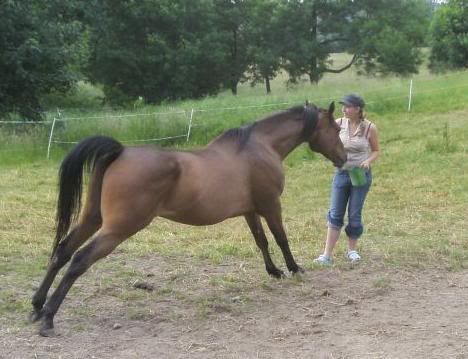 Bow (front crunch):
Bow (front crunch):The horse rotates his shoulder backwards/downwards with the front legs stretched out in front of him. A very good stretching exercise for the shoulders.
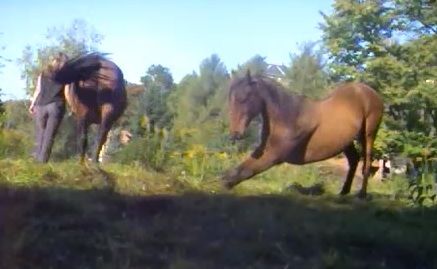 CCanter backwards:
CCanter backwards:An exercise invented by Jean Francois Baucher in the late 19th century. Seen by his contemporaries as just a trick, as according to the traditional dressage the horse should always be thinking forwards - except when going backwards at walk. The canter backwards (galop en arriere) is a tree-beat to four-beat canter going back.
Movie:
http://www.equinveste.com/media/Galop%2 ... 0Jun06.wmvCanter on three legs:An exercise invented by Jean Francois Baucher in the late 19th century. It was called: 'Galop sur trois jambes'. During the collected canter the horse keeps his inner front leg stretched out or at least bent in the air all the time.
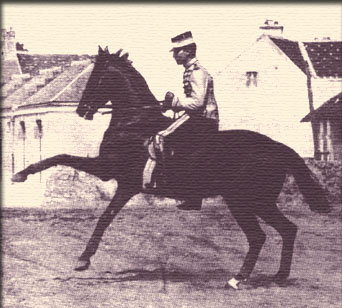
Movie:
http://www.equinveste.com/media/Galopsur3jambes.wmvCapriole:Haute Ecole movement, or Air above the ground: the horse jumps up with all four legs in the air in a ballotade, and at the highest point of the jump when his back is horizontal in the air, he kicks with the hind legs backwards. The classical ideal is that the horse lands on his hind legs first again. The capriole was meant as weapon in combat, and which can be dangerous to train for the human. A safer alternative is the croupade or the ballotade: the horse still jumps up in the same way, but without lashing out with the hind legs. See also Standing Capriole for a variant of this movement.

Movie:
http://www.youtube.com/watch?v=fcKfn2Qg ... re=relatedClickertraining:Developed for training dolphins, also very popular in dog-training. The clicker (a plastic box with a metal strip that makes a 'click-clack' sound when you push it) acts as a reward-signal: You teach your horse that the click-clack means: '
THIS is a great movement, I will give you a food reward for
thatmoment exactly.' The click gives timing to your piece of carrot, which will otherwise always come seconds to minutes
after the moment that you want to reward for: at the wrong time. The carrot now still comes seconds/minutes after that perfect moment, but the horse knows that he earned it with the behavior that earned him the click. As the clicker is just a reward-signal, you can also clicker train without the clicker, but with a specific word (for example 'perfect!') or sound (for example a tongue-click or whistle) as a reward-signal. As long as your horse always gets a reward right after that specific signal, he will know that that signal is a reward-signal.
Contingency There can be different relations between the horse´s behaviour and the reward. The degree to which the behaviour predicts the reward is called contingency. Perfect contingency would be if the horse is rewarded each time he offers the behaviour. No contingency would mean that there is no relation between behaviour and reward: if the horse is rewarded or not, does not depend on his behaviour. Contingency is a precondition for learning to show a behaviour. The more contingency exists between behaviour and reward, the faster the horse learns. But perfect contingency also makes the behaviour more vulnerable to extinction if there is no reinforcement anymore, whereas an imperfect contingency makes it more resistant to extinction. This is because in the latter case the horse learns that maybe more reactions may be necessary to get the reward. An example is the dog who is constantly begging for food at the table, even when only gets a piece of sausage every 10 minutes.
Courbette:Haute Ecole movement, or Air above the ground: The horse rears up in a pesade, and then jumps forward with the hind legs, the front legs still in the air. A horse can make one courbette-jump or more in a row, with the front legs staying in the air while the horse jumps forwards on the hind legs.
[img]http://www.imagineahorse.com/ImagineWebsite/Courbette2003w©.JPG[/img]
Movie:
http://www.youtube.com/watch?v=Q8HifuSuqRgCroupade:A movement in which a horse jumps up from a pesade (or levade?) with all four legs drawn up under it and lands on four legs at the same time.
 DDressage in hand:
DDressage in hand:Training dressage while walking at shoulder-height along with the horse. This position is used in the classical dressage to teach the horse exercises on the ground, before asking them from the saddle. All dressage maneuvers up to the Haute Ecole jumps can be performed like this.
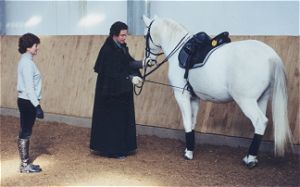
Movie:
http://video.google.com/videoplay?docid ... 4201878740EFGHHaute Ecole (dressage):Haute Ecole is the dressage of the 16th to 17th century when the Thoroughbred hadn't evolved yet. The Haute Ecole grand masters such as Antoine de Pluvinel and Francois de la Gueriniere worked with classical, baroque breeds such as Andalusians, Lusitanos and Barbs. It focused on collection up to the highest degree, to be seen the forgotten 'Airs above the ground', or Haute Ecole jumps such as the levade, capriole, courbette, terre a terre etc. Although the training methods were mostly brutal and the tools were harsh, the aim was to ride with invisible cues and with total collection with the reins hanging through. This means that horses can collect without steady support with the reins too - and therefore that they can collect without bridle, halter or any gear too once they realize how.
Haunches in (Travers):Also called Travers: a dressage sideways movement. While in shoulder-in the horse bends his head away from the direction his body is moving sideways to, in travers he bends his head towards the direction his body is moving sideways to. In a haunches-in to the right the horse is bending his head/neck to the right with his haunches to the right so that his left hind leg follows the line of travel of his front right leg.


Movie:
http://www.youtube.com/watch?v=YYU9z1QBWMIMovie:
http://www.youtube.com/watch?v=CKEbJ-jomg4IJJambetteIn the jambette the horse stretches a front leg horizontally in front of the chest in halt. It's a preparation for the Spanish walk, when the horse lifts his front legs up to the horizontal in walk. The jambette lifts and stretches the shoulders.
 KLLearning systems: rewards and corrections
KLLearning systems: rewards and corrections:
Training a horse means changing his behavior (for example, you want to teach him to walk on cue, or to walk sideways). You can change his behavior by giving a reaction to what he does: you can reward and punish your horse for the behavior in both two ways. This results in four methods:
- positive reinforcement: rewarding your horse by adding a pleasant stimulus, like giving a treat,
- negative reinforcement: rewarding your horse by taking away an unpleasant stimulus, like stopping to touch the horse´s leg when he lifts it, or release pressure on the lead rope when the horse halts,
- positive punishment: punishing your horse by adding an unpleasant stimulus, like pulling at the lead rope if he doesn't respond to a voice cue for halt,
- negative punishment: punishing the horse by taking away a pleasant stimulus, like a favorite target if the horse gets crowdy, or take away a treat if he grabs too wild at it.
A fifth reaction to the behavior your horse shows, is punishing your horse by ignoring the behavior he shows, so in fact by not rewarding him with your attention, which therefore actually is a form of negative punishment: you stop doing something your horse likes.
Levade:
A movement of the classical dressage, specifically the Haute Ecole. It is ranged among the 'Airs above the ground' because the horse lifts both front legs from the ground at the same time in a kind of rear. The levade is a collected rear: the horse stands with the hind legs bent in the joints and placed far under the body folds his front legs under his body without lifting his rump very high - and holds this pose for a couple of seconds. The ideal from the Spanish Riding School in Vienna is that the horses' back in the levade doesn't exceed a 30 degrees angle with the ground.

Movie:
http://www.youtube.com/watch?v=-GKk59RQ ... re=relatedMMezair:A Haute Ecole movement which looks like the terre a terre: It is similar to a series of levades with a forward motion (not in place), with the horse gradually bringing its legs further under himself and raises himself more in each successive movement and lightly touching the ground with his front legs before pushing up again. While in the terre a terre the horse keeps his body more horizontal, in the mezair he raises his body further upwards. The meziar was originally called the courbette by the old dressage masters, and it is no longer practiced at the Spanish Riding School.
 Mimicry
MimicryAnimals (and also humans) tend to mimic the behaviour of their partners in their communication. That means that they show the same behaviour or expression as the other one. A human example is that you will probably smile when someone smiles at you. In most cases this mimicry (also called mirroring) happens without awareness in every kind of natural communication, but you can also use it for creating a refined communication with your horse and for teaching him new movements or behaviours. You just do the movements you want your horse to do horse and reward him when he mimics you. You can also start by mimicking the behavior your horse does. Soon he will become more aware of your movements and try to imitate them. This helps you in teaching more difficult movements (e.g. Piaffe) without using pressure and in communicating with more subtle body language cues that can replace explicit cues. Another advantage is that it will make the communication more natural and increase rapport between you and your horse.
NOPParelli Natural HorsemanshipParelli Natural Horsemanship is a natural horsemanship method that is most well known for 'the seven games' in groundwork. The Parelli system is based on pressure and release (a form of positive punishment and negative reinforcement), but they seem to be using more treats recently (2007) and also have started to focus more on the horses' character and dressage riding techniques (especially Linda Parelli).
PesadeA Haute Ecole rear: The pesade is almost exactly like the levade. The only difference in how it looks is that the angle the horses' body makes with the ground is always above 45 degrees. This demands a bit less strength of the horse.
Piaffe
Movie:
http://video.google.com/videoplay?docid ... &plindex=0Positive punishment:
Positive punishment (adding more pressure if your horse doesn't respond to a lighter cue) combined with negative reinforcement (the release of pressure) is the teaching tool used in most NH methods: it's also known as the pressure-release system. The problem with this system is that the horse is avoidance motivated: he will do all kinds of things to reduce the pressure, but not become active and creative himself, because with showing initiative he risks getting more corrections. He will do what he has to do, but hardly more than necessary. Within AND, we use positive reinforcement (rewards like food, love, attention) as main teaching tool. The main advantage is that it builds up motivation and activity. The horse learns that he can get what he wants (attention, treats…) as a consequence of his own activity – so that he will be motivated to become more involved in the training, show more initiative and offer new behavior on his own.
QRSSchool walk:The original School Walk (Pas d’Ecole) is a raised, diagonal walk: the horse moves the right hind leg and left front leg forwards at the same time, and then the left hind and right front, without a moment of suspension between it like you would have in trot. It is very different of the school walk that the Cadre Noir shows nowadays, which is more a beginning of Spanish walk.
Seven GamesThe Seven Games of Parelli Natural Horsemanship: Friendly Game (desensitization), Porcupine Game (horse moving away from steady pressure, like your finger tips), Driving Game (horse moving away from rhythmic pressure, with or without contact with the horses' body), Yo-Yo Game (going backwards and forwards in a straight line- most often by wiggling the rope), Circling game (similar to longing), Sideways Game (sideways away from the trainer), Squeeze Game (sending horse between, over or under obstacles).
ShapingShaping is a teaching tool. For example, you wish that the horse does a particular movement (e.g. Spanish walk). As soon as he offers a behaviour that is a starting point for the Spanish walk, like lifting a leg, you reward for that it. Slowly you start rewarding only for the reactions that look more like the Spanish walk, for example by rewarding more or only when he lifts the leg higher. By rewarding with a precise timing (only for the highest movement of the leg), you shape the behavior from what your horse shows initially (lifting a leg) to what you really want him to do.
Shoulder-inShoulder in is a sideways movement. In a shoulder-in to the right, the horse will bend his body to the right, taking the head and shoulders to the inside of the arena, while still following the wall: the right hind leg will follow the line of travel of the front left leg: this way the horse is moving on three instead of two tracks (see picture). This engages the right hind leg causing it to step further under the horse's torso that therefore bearing more weight. This will also lift and relax the horse's back.

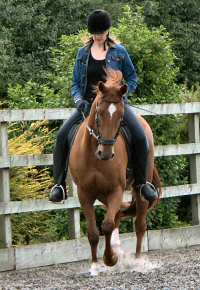
Movie:
http://www.youtube.com/watch?v=XtFykYh6 ... re=relatedMovie of a horse learning the shoulder-in:
http://www.youtube.com/watch?v=CN8Z5ioW ... re=relatedShoulder-out: Is the same as counter shoulder-in: your horse now bends his head and shoulders towards the fence (so riding on the right clockwise hand he will bend to the left). The left hind foot and left frontfoot will share the same line of travel.
Spanish trot:A highly collected trot, developed out of the Spanish walk and the passage, in which the horse stretches his front legs horizontal every step.

Movie:
http://www.equinveste.com/media/Trot%20 ... 0Jun06.wmvSpanish walk:A highly collected walk, in which the horse stretches his frontlegs more or less horizontal with every stride.

Movie:
http://www.equinveste.com/media/MARV2.wmvStanding CaprioleThere are two sorts of capriole - the standing capriole and the capriole. The standing capriole is a half air. The horse stands on its front legs and kicks out with its hind legs, in other words it is a controlled lash out.
 Stimulus control
Stimulus controlStimulus control means that your horse is only rewarded when he does an exercise after you gave the cue for it. If he does it without the cue, he won't get the reward either. You let the unwanted behavior fade out by ignoring (not rewarding) it. So your horse learns to perform the exercise only when asked for it. This makes the communication more controlled and can be especially necessary for exercises that are potentially dangerous in some situations, like rearing. The other side is that the more stimulus control you use, the less spontaneous your communication will become and the horse will have less room for creativity. To benefit from the advantages of stimulus control and to minimize the disadvantages at the same time, you can specify a situation, for example a certain place, where your horse is free to offer what he wants to, while in another spot/time he is only allowed to follow your cues.
TTerre a terre:A Haute Ecole dressage movement, one of the airs above the ground as the horse lifts both front legs at the same time. The Terre a terre is a very collected two-beat canter, in which the horse jumps forwards with both front legs. When they have landed, the hind legs follow with a simultaneous jump forwards, then the front legs again, then the hind legs. You can also describe it as a series of levades, in which the hind legs jump forwards between each levade. The difference with the other haute ecole jumps is that there are always two legs on the ground.
Movie:
http://www.youtube.com/watch?v=LYYk5A1ao0sTiming:In order to reinforce behavior, you need to react with a precise timing. With this timing (or contiguity) is meant the time between the behaviour and its consequences. Learning occurs in the most effective way when behaviour and consequence are very close to each other. This principle is used for example in clicker training, where the timely precision of the clicker makes it possible that the reward signal follows the behaviour immediately so that the horse knows exactly what the piece of carrot that is delivered next was meant for.
Travers:See Haunches-in.
UVWXYZ